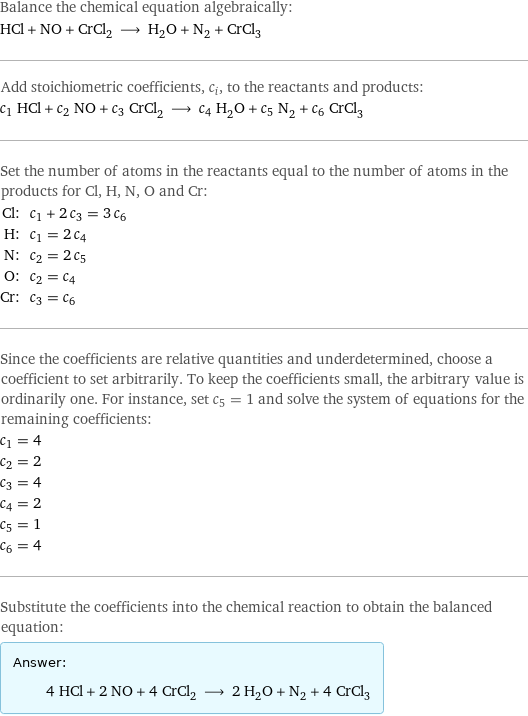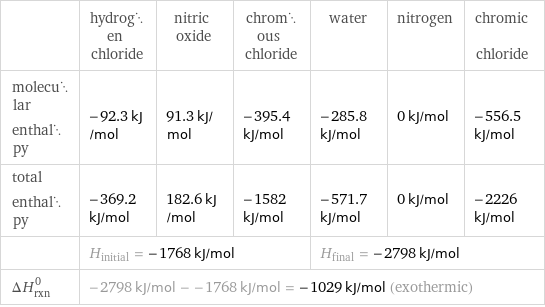Input interpretation

HCl hydrogen chloride + NO nitric oxide + CrCl_2 chromous chloride ⟶ H_2O water + N_2 nitrogen + CrCl_3 chromic chloride
Balanced equation

Balance the chemical equation algebraically: HCl + NO + CrCl_2 ⟶ H_2O + N_2 + CrCl_3 Add stoichiometric coefficients, c_i, to the reactants and products: c_1 HCl + c_2 NO + c_3 CrCl_2 ⟶ c_4 H_2O + c_5 N_2 + c_6 CrCl_3 Set the number of atoms in the reactants equal to the number of atoms in the products for Cl, H, N, O and Cr: Cl: | c_1 + 2 c_3 = 3 c_6 H: | c_1 = 2 c_4 N: | c_2 = 2 c_5 O: | c_2 = c_4 Cr: | c_3 = c_6 Since the coefficients are relative quantities and underdetermined, choose a coefficient to set arbitrarily. To keep the coefficients small, the arbitrary value is ordinarily one. For instance, set c_5 = 1 and solve the system of equations for the remaining coefficients: c_1 = 4 c_2 = 2 c_3 = 4 c_4 = 2 c_5 = 1 c_6 = 4 Substitute the coefficients into the chemical reaction to obtain the balanced equation: Answer: | | 4 HCl + 2 NO + 4 CrCl_2 ⟶ 2 H_2O + N_2 + 4 CrCl_3
Structures

+ + ⟶ + +
Names

hydrogen chloride + nitric oxide + chromous chloride ⟶ water + nitrogen + chromic chloride
Reaction thermodynamics
Enthalpy

| hydrogen chloride | nitric oxide | chromous chloride | water | nitrogen | chromic chloride molecular enthalpy | -92.3 kJ/mol | 91.3 kJ/mol | -395.4 kJ/mol | -285.8 kJ/mol | 0 kJ/mol | -556.5 kJ/mol total enthalpy | -369.2 kJ/mol | 182.6 kJ/mol | -1582 kJ/mol | -571.7 kJ/mol | 0 kJ/mol | -2226 kJ/mol | H_initial = -1768 kJ/mol | | | H_final = -2798 kJ/mol | | ΔH_rxn^0 | -2798 kJ/mol - -1768 kJ/mol = -1029 kJ/mol (exothermic) | | | | |
Gibbs free energy

| hydrogen chloride | nitric oxide | chromous chloride | water | nitrogen | chromic chloride molecular free energy | -95.3 kJ/mol | 87.6 kJ/mol | -356 kJ/mol | -237.1 kJ/mol | 0 kJ/mol | -486.1 kJ/mol total free energy | -381.2 kJ/mol | 175.2 kJ/mol | -1424 kJ/mol | -474.2 kJ/mol | 0 kJ/mol | -1944 kJ/mol | G_initial = -1630 kJ/mol | | | G_final = -2419 kJ/mol | | ΔG_rxn^0 | -2419 kJ/mol - -1630 kJ/mol = -788.6 kJ/mol (exergonic) | | | | |
Equilibrium constant
![Construct the equilibrium constant, K, expression for: HCl + NO + CrCl_2 ⟶ H_2O + N_2 + CrCl_3 Plan: • Balance the chemical equation. • Determine the stoichiometric numbers. • Assemble the activity expression for each chemical species. • Use the activity expressions to build the equilibrium constant expression. Write the balanced chemical equation: 4 HCl + 2 NO + 4 CrCl_2 ⟶ 2 H_2O + N_2 + 4 CrCl_3 Assign stoichiometric numbers, ν_i, using the stoichiometric coefficients, c_i, from the balanced chemical equation in the following manner: ν_i = -c_i for reactants and ν_i = c_i for products: chemical species | c_i | ν_i HCl | 4 | -4 NO | 2 | -2 CrCl_2 | 4 | -4 H_2O | 2 | 2 N_2 | 1 | 1 CrCl_3 | 4 | 4 Assemble the activity expressions accounting for the state of matter and ν_i: chemical species | c_i | ν_i | activity expression HCl | 4 | -4 | ([HCl])^(-4) NO | 2 | -2 | ([NO])^(-2) CrCl_2 | 4 | -4 | ([CrCl2])^(-4) H_2O | 2 | 2 | ([H2O])^2 N_2 | 1 | 1 | [N2] CrCl_3 | 4 | 4 | ([CrCl3])^4 The equilibrium constant symbol in the concentration basis is: K_c Mulitply the activity expressions to arrive at the K_c expression: Answer: | | K_c = ([HCl])^(-4) ([NO])^(-2) ([CrCl2])^(-4) ([H2O])^2 [N2] ([CrCl3])^4 = (([H2O])^2 [N2] ([CrCl3])^4)/(([HCl])^4 ([NO])^2 ([CrCl2])^4)](../image_source/f88ef3421e45763c05f3d9e71a703a95.png)
Construct the equilibrium constant, K, expression for: HCl + NO + CrCl_2 ⟶ H_2O + N_2 + CrCl_3 Plan: • Balance the chemical equation. • Determine the stoichiometric numbers. • Assemble the activity expression for each chemical species. • Use the activity expressions to build the equilibrium constant expression. Write the balanced chemical equation: 4 HCl + 2 NO + 4 CrCl_2 ⟶ 2 H_2O + N_2 + 4 CrCl_3 Assign stoichiometric numbers, ν_i, using the stoichiometric coefficients, c_i, from the balanced chemical equation in the following manner: ν_i = -c_i for reactants and ν_i = c_i for products: chemical species | c_i | ν_i HCl | 4 | -4 NO | 2 | -2 CrCl_2 | 4 | -4 H_2O | 2 | 2 N_2 | 1 | 1 CrCl_3 | 4 | 4 Assemble the activity expressions accounting for the state of matter and ν_i: chemical species | c_i | ν_i | activity expression HCl | 4 | -4 | ([HCl])^(-4) NO | 2 | -2 | ([NO])^(-2) CrCl_2 | 4 | -4 | ([CrCl2])^(-4) H_2O | 2 | 2 | ([H2O])^2 N_2 | 1 | 1 | [N2] CrCl_3 | 4 | 4 | ([CrCl3])^4 The equilibrium constant symbol in the concentration basis is: K_c Mulitply the activity expressions to arrive at the K_c expression: Answer: | | K_c = ([HCl])^(-4) ([NO])^(-2) ([CrCl2])^(-4) ([H2O])^2 [N2] ([CrCl3])^4 = (([H2O])^2 [N2] ([CrCl3])^4)/(([HCl])^4 ([NO])^2 ([CrCl2])^4)
Rate of reaction
![Construct the rate of reaction expression for: HCl + NO + CrCl_2 ⟶ H_2O + N_2 + CrCl_3 Plan: • Balance the chemical equation. • Determine the stoichiometric numbers. • Assemble the rate term for each chemical species. • Write the rate of reaction expression. Write the balanced chemical equation: 4 HCl + 2 NO + 4 CrCl_2 ⟶ 2 H_2O + N_2 + 4 CrCl_3 Assign stoichiometric numbers, ν_i, using the stoichiometric coefficients, c_i, from the balanced chemical equation in the following manner: ν_i = -c_i for reactants and ν_i = c_i for products: chemical species | c_i | ν_i HCl | 4 | -4 NO | 2 | -2 CrCl_2 | 4 | -4 H_2O | 2 | 2 N_2 | 1 | 1 CrCl_3 | 4 | 4 The rate term for each chemical species, B_i, is 1/ν_i(Δ[B_i])/(Δt) where [B_i] is the amount concentration and t is time: chemical species | c_i | ν_i | rate term HCl | 4 | -4 | -1/4 (Δ[HCl])/(Δt) NO | 2 | -2 | -1/2 (Δ[NO])/(Δt) CrCl_2 | 4 | -4 | -1/4 (Δ[CrCl2])/(Δt) H_2O | 2 | 2 | 1/2 (Δ[H2O])/(Δt) N_2 | 1 | 1 | (Δ[N2])/(Δt) CrCl_3 | 4 | 4 | 1/4 (Δ[CrCl3])/(Δt) (for infinitesimal rate of change, replace Δ with d) Set the rate terms equal to each other to arrive at the rate expression: Answer: | | rate = -1/4 (Δ[HCl])/(Δt) = -1/2 (Δ[NO])/(Δt) = -1/4 (Δ[CrCl2])/(Δt) = 1/2 (Δ[H2O])/(Δt) = (Δ[N2])/(Δt) = 1/4 (Δ[CrCl3])/(Δt) (assuming constant volume and no accumulation of intermediates or side products)](../image_source/57c94e344568f9dddee2310262eb54b2.png)
Construct the rate of reaction expression for: HCl + NO + CrCl_2 ⟶ H_2O + N_2 + CrCl_3 Plan: • Balance the chemical equation. • Determine the stoichiometric numbers. • Assemble the rate term for each chemical species. • Write the rate of reaction expression. Write the balanced chemical equation: 4 HCl + 2 NO + 4 CrCl_2 ⟶ 2 H_2O + N_2 + 4 CrCl_3 Assign stoichiometric numbers, ν_i, using the stoichiometric coefficients, c_i, from the balanced chemical equation in the following manner: ν_i = -c_i for reactants and ν_i = c_i for products: chemical species | c_i | ν_i HCl | 4 | -4 NO | 2 | -2 CrCl_2 | 4 | -4 H_2O | 2 | 2 N_2 | 1 | 1 CrCl_3 | 4 | 4 The rate term for each chemical species, B_i, is 1/ν_i(Δ[B_i])/(Δt) where [B_i] is the amount concentration and t is time: chemical species | c_i | ν_i | rate term HCl | 4 | -4 | -1/4 (Δ[HCl])/(Δt) NO | 2 | -2 | -1/2 (Δ[NO])/(Δt) CrCl_2 | 4 | -4 | -1/4 (Δ[CrCl2])/(Δt) H_2O | 2 | 2 | 1/2 (Δ[H2O])/(Δt) N_2 | 1 | 1 | (Δ[N2])/(Δt) CrCl_3 | 4 | 4 | 1/4 (Δ[CrCl3])/(Δt) (for infinitesimal rate of change, replace Δ with d) Set the rate terms equal to each other to arrive at the rate expression: Answer: | | rate = -1/4 (Δ[HCl])/(Δt) = -1/2 (Δ[NO])/(Δt) = -1/4 (Δ[CrCl2])/(Δt) = 1/2 (Δ[H2O])/(Δt) = (Δ[N2])/(Δt) = 1/4 (Δ[CrCl3])/(Δt) (assuming constant volume and no accumulation of intermediates or side products)
Chemical names and formulas

| hydrogen chloride | nitric oxide | chromous chloride | water | nitrogen | chromic chloride formula | HCl | NO | CrCl_2 | H_2O | N_2 | CrCl_3 Hill formula | ClH | NO | Cl_2Cr | H_2O | N_2 | Cl_3Cr name | hydrogen chloride | nitric oxide | chromous chloride | water | nitrogen | chromic chloride IUPAC name | hydrogen chloride | nitric oxide | dichlorochromium | water | molecular nitrogen | trichlorochromium